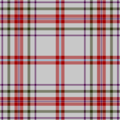File:Earasaid tartan reconstruction by Scarlett, centred, zoomed out.png

Size of this preview: 600 × 600 pixels. Other resolutions: 240 × 240 pixels | 480 × 480 pixels | 884 × 884 pixels.
Original file (884 × 884 pixels, file size: 7 KB, MIME type: image/png)
File history
Click on a date/time to view the file as it appeared at that time.
| Date/Time | Thumbnail | Dimensions | User | Comment | |
|---|---|---|---|---|---|
| current | 19:47, 25 June 2023 |  | 884 × 884 (7 KB) | SMcCandlish | {{Information |Description={{efn|1=This is a Commons user's self-made approximation of a tartan textile. The design is ultimately from James D. Scarlett (1990) ''Tartan: The Highland Textile'', p. 40 & plate 5(b). Scarlett did not provide the threadcount, just an image of woven cloth; this is a careful approximation of the pattern as shown in the image. Scarlett designed it to illustrate what 16th- and 17th-century earasaid (arisaid) tartan patterns {{em|basically}} would have looked like, t... |
File usage
No pages on the English Wikipedia use this file (pages on other projects are not listed).


